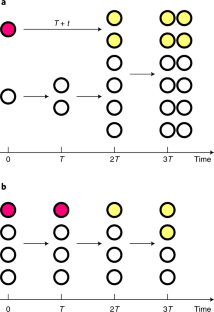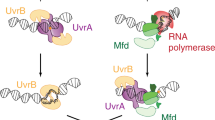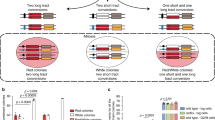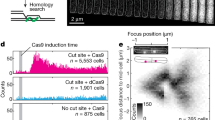Abstract
Checkpoints arrest biological processes, allowing time for error correction. The phenomenon of checkpoint override during cellular self-replication is biologically critical, but it currently lacks a quantitative, functional or system-level understanding. To uncover fundamental laws governing error correction systems, we derived a general theory of optimal checkpoint strategies, balancing the trade-off between risk and self-replication speed. Mathematically, the problem maps onto the optimization of an absorbing boundary for a random walk. We applied the theory to the DNA damage checkpoint in budding yeast, an intensively researched model checkpoint. Using novel reporters for double-strand DNA breaks (DSBs), we first quantified the probability distribution of DSB repair in time including rare events; second, we determined the survival probability after override. With these inputs, the optimal theory remarkably accurately predicted override times as a function of DSB numbers, which we precisely measured for the first time. Thus, a first-principles calculation revealed undiscovered patterns underlying highly noisy override processes. Our multi-DSB measurements revise well-known past results and show that override is more general than previously thought.
This is a preview of subscription content, access via your institution
Access options
Access Nature and 54 other Nature Portfolio journals
Get Nature+, our best-value online-access subscription
$29.99 / 30 days
cancel any time
Subscribe to this journal
Receive 12 print issues and online access
$209.00 per year
only $17.42 per issue
Buy this article
- Purchase on Springer Link
- Instant access to full article PDF
Prices may be subject to local taxes which are calculated during checkout





Similar content being viewed by others
Data availability
The data that support the findings of this study are available from the corresponding author upon reasonable request.
References
Jain, S. et al. A recombination execution checkpoint regulates the choice of homologous recombination pathway during DNA double-strand break repair. Genes Dev. 23, 291–303 (2009).
Rieder, C. L. & Maiato, H. Stuck in division or passing through: what happens when cells cannot satisfy the spindle assembly checkpoint. Dev. Cell. 7, 637–651 (2004).
Morgan, D. O. The Cell Cycle: Principles of Control (New Science Press, 2007).
Curtis, N. L., Ruda, G. F., Brennan, P. & Bolanos-Garcia, V. M. Deregulation of chromosome segregation and cancer. Annu. Rev. Cancer Biol. 4, 257–278 (2020).
Waterman, D. P., Haber, J. E. & Smolka, M. B. Checkpoint responses to DNA double-strand breaks. Annu. Rev. Biochem. 89, 103–133 (2020).
Galgoczy, D. J. & Toczyski, D. P. Checkpoint adaptation precedes spontaneous and damage-induced genomic instability in yeast. Mol. Cell. Biol. 21, 1710–1718 (2001).
SyljuÅsen, R. G. Checkpoint adaptation in human cells. Oncogene 26, 5833–5839 (2007).
Rossio, V., Galati, E. & Piatti, S. Adapt or die: how eukaryotic cells respond to prolonged activation of the spindle assembly checkpoint. Biochem. Soc. Trans. 38, 1645–1649 (2010).
Coutelier, H. et al. Adaptation to DNA damage checkpoint in senescent telomerase-negative cells promotes genome instability. Genes Dev. 32, 1499–1513 (2018).
Coutelier, H. & Xu, Z. Adaptation in replicative senescence: a risky business. Curr. Genet. 65, 711–716 (2019).
Halme, A., Cheng, M. & Hariharan, I. K. Retinoids regulate a developmental checkpoint for tissue regeneration in drosophila. Curr. Biol. 20, 458–463 (2010).
Hackney, J. F., Zolali-Meybodi, O. & Cherbas, P. Tissue damage disrupts developmental progression and ecdysteroid biosynthesis in Drosophila. PLoS ONE 7, e49105 (2012).
Lee, S. E. et al. Saccharomyces Ku70, Mre11/Rad50, and RPA proteins regulate adaptation to G2/M arrest after DNA damage. Cell 94, 399–409 (1998).
Lee, S. E. et al. Arrest, adaptation, and recovery following a chromosome double-strand break in Saccharomyces cerevisiae. Cold Spring Harb. Symp. Quant. Biol. 65, 303–314 (2000).
Aguda, B. D. A quantitative analysis of the kinetics of the G2 DNA damage checkpoint system. Proc. Natl Acad. Sci. USA 96, 11352–11357 (1999).
Kesseler, K. J., Blinov, M. L., Elston, T. C., Kaufmann, W. K. & Simpson, D. A. A predictive mathematical model of the DNA damage G2 checkpoint. J. Theor. Biol. 320, 159–169 (2013).
Bonaiuti, P. et al. Cells escape an operational mitotic checkpoint through a stochastic process. Curr. Biol. 28, 28–37 (2018).
Hopfield, J. J. Kinetic proofreading: a new mechanism for reducing errors in biosynthetic processes requiring high specificity. Proc. Natl Acad. Sci. USA 71, 4135–4139 (1974).
Ninio, J. Kinetic amplification of enzyme discrimination. Biochimie 57, 587–595 (1975).
Berg, H. & Purcell, E. Physics of chemoreception. Biophys. J. 20, 193–219 (1977).
Ehrenberg, M. & Blomberg, C. Thermodynamic constraints on kinetic proofreading in biosynthetic pathways. Biophys. J. 31, 333–358 (1980).
Freter, R. R. & Savageau, M. A. Proofreading systems of multiple stages for improved accuracy of biological discrimination. J. Theor. Biol. 85, 99–123 (1980).
Savageau, M. A. & Lapointe, D. S. Optimization of kinetic proofreading: a general method for derivation of the constraint relations and an exploration of a specific case. J. Theor. Biol. 93, 157–177 (1981).
McKeithan, T. W. Kinetic proofreading in T-cell receptor signal transduction. Proc. Natl Acad. Sci. USA 92, 5042–5046 (1995).
Perkins, T. J. & Swain, P. S. Strategies for cellular decision-making. Mol. Syst. Biol. 5, 326 (2009).
Murugan, A., Huse, D. A. & Leibler, S. Speed, dissipation, and error in kinetic proofreading. Proc. Natl Acad. Sci. USA 109, 12034–12039 (2012).
Lan, G., Sartori, P., Neumann, S., Sourjik, V. & Tu, Y. The energy–speed–accuracy trade-off in sensory adaptation. Nat. Phys. 8, 422–428 (2012).
Sartori, P., Granger, L., Lee, C. F. & Horowitz, J. M. Thermodynamic costs of information processing in sensory adaptation. PLoS Comput. Biol. 10, e1003974 (2014).
Rao, R. & Peliti, L. Thermodynamics of accuracy in kinetic proofreading: dissipation and efficiency trade-offs. J. Stat. Mech. 2015, P06001 (2015).
tenWolde, P. R., Becker, N. B., Ouldridge, T. E. & Mugler, A. Fundamental limits to cellular sensing. J. Stat. Phys. 162, 1395–1424 (2016).
Banerjee, K., Kolomeisky, A. B. & Igoshin, O. A. Elucidating interplay of speed and accuracy in biological error correction. Proc. Natl Acad. Sci. USA 114, 5183–5188 (2017).
Cui, W. & Mehta, P. Identifying feasible operating regimes for early T-cell recognition: the speed, energy, accuracy trade-off in kinetic proofreading and adaptive sorting. PLoS ONE 13, e0202331 (2018).
Wong, F., Amir, A. & Gunawardena, J. Energy-speed-accuracy relation in complex networks for biological discrimination. Phys. Rev. E 98, 012420 (2018).
Mallory, J. D., Kolomeisky, A. B. & Igoshin, O. A. Trade-offs between error, speed, noise, and energy dissipation in biological processes with proofreading. J. Phys. Chem. B 123, 4718–4725 (2019).
Lee, S. E., Pâques, F., Sylvan, J. & Haber, J. E. Role of yeast SIR genes and mating type in directing DNA double-strand breaks to homologous and non-homologous repair paths. Curr. Biol. 9, 767–770 (1999).
Sandell, L. L. & Zakian, V. A. Loss of a yeast telomere: arrest, recovery, and chromosome loss. Cell 75, 729–739 (1993).
Toczyski, D. P., Galgoczy, D. J. & Hartwell, L. H. CDC5 and CKII control adaptation to the yeast DNA damage checkpoint. Cell 90, 1097–1106 (1997).
Leroy, C. et al. PP2C phosphatases Ptc2 and Ptc3 are required for DNA checkpoint inactivation after a double-strand break. Mol. Cell. 11, 827–835 (2003).
Haber, J. E. A life investigating pathways that repair broken chromosomes. Annu. Rev. Genet. 50, 1–28 (2016).
Chiruvella, K. K., Liang, Z. & Wilson, T. E. Repair of double-strand breaks by end joining. Cold Spring Harb. Perspect. Biol. 5, a012757 (2013).
Wu, D., Topper, L. M. & Wilson, T. E. Recruitment and dissociation of nonhomologous end joining proteins at a DNA double-strand break in Saccharomyces cerevisiae. Genetics 178, 1237–1249 (2008).
Muñoz-Galván, S. et al. Competing roles of DNA end resection and non-homologous end joining functions in the repair of replication-born double-strand breaks by sister-chromatid recombination. Nucleic Acids Res. 41, 1669–1683 (2012).
Balestrini, A. et al. The Ku heterodimer and the metabolism of single-ended DNA double-strand breaks. Cell Rep. 3, 2033–2045 (2013).
Chiruvella, K. K., Liang, Z., Birkeland, S. R., Basrur, V. & Wilson, T. E. Saccharomyces cerevisiae DNA ligase IV supports imprecise end joining independently of its catalytic activity. PLoS Genet. 9, e1003599 (2013).
Liang, Z., Sunder, S., Nallasivam, S. & Wilson, T. E. Overhang polarity of chromosomal double-strand breaks impacts kinetics and fidelity of yeast non-homologous end joining. Nucleic Acids Res. 44, 2769–2781 (2016).
Crow, J. F. & Kimura, M. An Introduction to Population Genetics Theory (The Blackburn Press, 1970).
Orr, H. A. Fitness and its role in evolutionary genetics. Nat. Rev. Genet. 10, 531–539 (2009).
Roux, P., Salort, D. & Xu, Z. Adaptation to DNA damage as a bet-hedging mechanism in a fluctuating environment. R. Soc. Open Sci. 8, 210460 (2021).
Kelly, J. L. Jr A new interpretation of information rate. Bell Syst. Tech. J. 35, 917–926 (1956).
Amon, A., Irniger, S. & Nasmyth, K. Closing the cell cycle circle in yeast: G2 cyclin proteolysis initiated at mitosis persists until the activation of G1 cyclins in the next cycle. Cell 77, 1037–1050 (1994).
Kaplun, L., Ivantsiv, Y., Kornitzer, D. & Raveh, D. Functions of the DNA damage response pathway target Ho endonuclease of yeast for degradation via the ubiquitin-26S proteasome system. Proc. Natl Acad. Sci. USA 97, 10077–10082 (2000).
Dietler, N. et al. A convolutional neural network segments yeast microscopy images with high accuracy. Nat. Commun. 11, 5723 (2020).
Kaboli, S. et al. Genome-wide mapping of unexplored essential regions in the Saccharomyces cerevisiae genome: evidence for hidden synthetic lethal combinations in a genetic interaction network. Nucleic Acids Res. 42, 9838–9853 (2014).
Haber, J. E. Mating-type genes and MAT switching in Saccharomyces cerevisiae. Genetics 191, 33–64 (2012).
Eapen, V. V., Sugawara, N., Tsabar, M., Wu, W.-H. & Haber, J. E. The Saccharomyces cerevisiae chromatin remodeler Fun30 regulates DNA end resection and checkpoint deactivation. Mol. Cell. Biol. 32, 4727–4740 (2012).
Fudenberg, D. & Tirole, J. Game Theory (MIT Press, 1991).
Bertsekas, D. P. Dynamic Programming and Optimal Control (Athena Scientific, 2017).
Elserafy, M. & El-Khamisy, S. F. Choose your yeast strain carefully: the RAD5 gene matters. Nat. Rev. Mol. Cell Biol. 19, 343–344 (2018).
Acknowledgements
S.J.R. thanks F. R. Cross, J. E. Haber, F. Zhou and A. Pellicioli for fruitful discussions, as well as E. Alani for the reagents. We thank E. Tenaglia for technical advice and help with strain construction. We thank P. Ehsani for technical advice and reagents. This work was supported by funding from École polytechnique fédérale de Lausanne (EPFL) (S.J.R.) and SNSF Division III project grant 310030_204938 (S.J.R.).
Author information
Authors and Affiliations
Contributions
A.S. performed the FACS and microscopy measurements and was helped with the latter by V.G. and M.L. A.S., R.D. and S.J.R. made the constructs and strains. A.S. analysed the data and was helped by R.D. and S.J.R. A.S. performed the numerical calculations. S.J.R. wrote the manuscript. S.J.R. devised the theory and analytical calculations. All the authors contributed to reviewing and editing the article.
Corresponding author
Ethics declarations
Competing interests
The authors declare no competing interests.
Peer review
Peer review information
Nature Physics thanks the anonymous reviewers for their contribution to the peer review of this work.
Additional information
Publisher’s note Springer Nature remains neutral with regard to jurisdictional claims in published maps and institutional affiliations.
Supplementary information
Supplementary Information
Supplementary Notes 1–10 and Supplementary Figs. 1–11.
Rights and permissions
About this article
Cite this article
Sadeghi, A., Dervey, R., Gligorovski, V. et al. The optimal strategy balancing risk and speed predicts DNA damage checkpoint override times. Nat. Phys. 18, 832–839 (2022). https://doi.org/10.1038/s41567-022-01601-3
Received:
Accepted:
Published:
Issue Date:
DOI: https://doi.org/10.1038/s41567-022-01601-3
This article is cited by
-
In vivo tracking of functionally tagged Rad51 unveils a robust strategy of homology search
Nature Structural & Molecular Biology (2023)
-
Multidimensional characterization of inducible promoters and a highly light-sensitive LOV-transcription factor
Nature Communications (2023)



